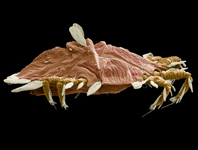Abstract
A new species, Prolixus splendens sp. nov., collected from leaves of the grass Austroderia splendens (Poaceae) in Auckland, New Zealand, is described and illustrated. Only five species of Prolixus have previously been reported, and all were recorded from the genus Gahnia (Cyperaceae). In this paper, we present the ontogenetic additions in idiosomal and leg chaetotaxy from larva to adult for the new species. A key to world species of Prolixus is also proposed.
References
Beard, J.J., Fan, Q.-H. & Walter, D.E. (2005) A new genus and two new species of Tenuipalpidae (Prostigmata: Tetranychoidea) from an Australian sedge. Acarologia, 45, 161–181.
Beard, J.J. & Ochoa, R. (2011) New flat mite genera (Acari: Trombidiformes: Tenuipalpidae) associated with Australian sedges (Cyperaceae). Zootaxa, 2941, 1–37.
Beard, J.J., Ochoa, R., Bauchan, G.R., Trice, M.D., Redford, A.J., Walters, T.W. & Mitter, C. (2012) Flat Mites of the World. Edition 2. Identification Technology Program, CPHST, PPQ, APHIS, USDA, Fort Collins, CO. Available from: http://idtools.org/id/mites/flatmites/index.php (Accessed 15 August 2018)
Lindquist, E.E. (1985) External anatomy. In: Helle, W. & Sabelis, M.W. (Eds.), Spider Mites: Their Biology, Natural Enemies and Control. Vol. 1a. Elsevier, Amsterdam, pp. 3–28.
Mesa, N.C., Ochoa, R., Welbourn, W.C., Evans, G.A. & de Moraes, G.J. (2009) A catalog of the Tenuipalpidae (Acari) of the World with a key to genera. Zootaxa, 2098, 1–185.
Saito, Y., Kotaro, M. & Chittenden, A.R. (1999) Body characters reflecting the body size of spider mites in flattened specimens (Acari: Tetranychidae). Applied Entomology and Zoology, 34, 383–386.
https://doi.org/10.1303/aez.34.383
Seeman, O.D. & Beard, J.J. (2011) A new species of Aegyptobia (Acari: Tenuipalpidae) from Myrtaceae in Australia. Systematic and Applied Acarology, 16, 73–89.
https://doi.org/10.11158/saa.16.1.10
Xu, Y. & Zhang, Z.-Q. (2013) New Zealand Tenuipalpidae (Acari: Trombidiformes): A new species of Acaricis from Cyperaceae and its ontogenetic patterns in chaetotaxy. Systematic & Applied Acarology, 18 (4), 357–388.
https://doi.org/10.11158/saa.18.4.6
Xu, Y. & Zhang, Z.-Q. (2014) Prolixus (Acari: Trombidiformes: Tenuipalpidae) newly recorded from New Zealand: A new species from Cyperaceae and its ontogenetic patterns in chaetotaxy. Zootaxa, 3900 (1), 1–20.
https://doi.org/10.11646/zootaxa.3900.1.1
Xu, Y., Fan, Q-H. & Huang, J. (2015) Description and ontogeny of Krugeria fuzhouensis sp. nov. (Acari: Trombidiformes: Tenuipalpidae). Systematic & Applied Acarology, 20 (1), 87–109.
https://doi.org/10.11158/saa.20.1.9
Xu, Y., Fan, Q-H., Zhang, F.-P. & Huang, J. (2017a) Morphological ontogeny in Aegyptobia exarata Livchitz & Mitrofanov (Acari: Tenuipalpidae). Systematic & Applied Acarology, 22 (7), 968–979.
https://doi.org/10.11158/saa.22.7.6
Xu, Y., Huang, J. & Zhang, Z.-Q. (2017b) Two new species of Prolixus (Acari: Trombidiformes: Tenuipalpidae) on Gahnia (Cyperaceae) from New Zealand. Systematic & Applied Acarology, 22 (10), 1521–1559.
https://doi.org/10.11158/saa.22.10.1
Zhang, Z.-Q. & Fan, Q.-H. (2004) Redescription of Dolichotetranychus ancistrus Baker & Pritchard (Acari: Tenuipalpidae) from New Zealand. Systematic & Applied Acarology, 9, 111–131.

